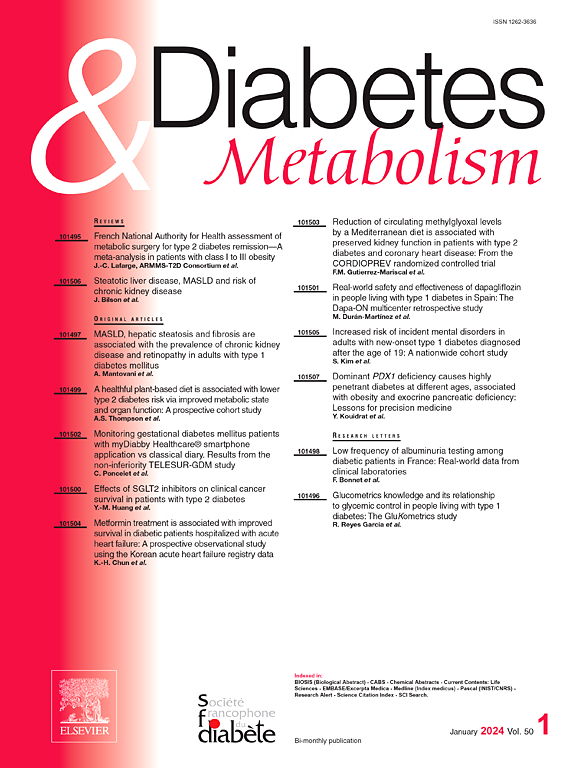Automated insulin delivery after beta-cell replacement failure in people living with type 1 diabetes
IF 4.7
2区 医学
Q1 ENDOCRINOLOGY & METABOLISM
引用次数: 0
Abstract
Aims
Patients living with highly unstable type 1 diabetes (T1D) are eligible for beta-cell replacement (βCR) therapy (islet or pancreas transplantation). This study aimed to evaluate glycemic control in patients treated with automated insulin delivery (AID) following failed βCR therapy, defined as secondary graft failure or marginal function.
Material and Methods
A national, multicenter, retrospective study was conducted with 23 patients who had βCR failure treated with AID for at least three months. The primary outcome was the proportion of patients achieving recommended glucose targets (time in 70–180mg/dl range [TIR] > 70 %, time below range [TBR] < 4 % and HbA1c < 7 %). Secondary outcomes included TIR, glycemia risk index (GRI), HbA1c, coefficient of variation (CV), body weight, insulin doses, severe hypoglycemia and AID discontinuation.
Results
The proportion of patients achieving recommended glucose targets under AID increased from 5.0 % to 57.1 % after 12 months. TIR increased from 54.2 ± 18.0 % to 75.5 ± 9.6 % after 12-month AID, while GRI decreased from 45.8 ± 22.2 % to 25.6 ± 10.3 %. HbA1c levels decreased from 7.5 ± 0.9 % to 7.0 ± 1.1 % after 12-month AID. CV, body weight and insulin doses did not change. All patients were free from severe hypoglycemia under AID, including those who had experienced severe hypoglycemia after βCR failure. No patient discontinued the AID.
Conclusions
This study highlights the effectiveness of AID in achieving glucose control targets and preventing severe hypoglycemia in patients with T1D following βCR failure. AID may serve as a valuable therapeutic option to improve glucose control when graft function declines.
1型糖尿病患者β细胞替代失败后的自动胰岛素输送
高度不稳定型1型糖尿病(T1D)患者适合β细胞替代(βCR)治疗(胰岛或胰腺移植)。本研究旨在评估βCR治疗失败(继发性移植物衰竭或边缘功能)后接受自动胰岛素输送(AID)治疗的患者的血糖控制情况。材料与方法对23例经AID治疗至少3个月的βCR失败患者进行了一项全国性、多中心、回顾性研究。主要终点是达到推荐血糖目标的患者比例(在70-180mg /dl范围内的时间[TIR] >;70%,时间低于范围[TBR] <;4%和HbA1c <;7%)。次要结局包括TIR、血糖危险指数(GRI)、糖化血红蛋白(HbA1c)、变异系数(CV)、体重、胰岛素剂量、严重低血糖和停药。结果12个月后,AID下达到推荐血糖指标的患者比例从5.0%上升到57.1%。12个月后,TIR由54.2±18.0%上升至75.5±9.6%,GRI由45.8±22.2%下降至25.6±10.3%。艾滋病12个月后,HbA1c水平从7.5±0.9%降至7.0±1.1%。CV、体重和胰岛素剂量没有变化。所有患者在AID下均无严重低血糖,包括βCR失败后出现严重低血糖的患者。没有患者停药。结论本研究强调了AID在T1D患者βCR失效后实现血糖控制目标和预防严重低血糖的有效性。当移植物功能下降时,AID可作为改善血糖控制的有价值的治疗选择。
本文章由计算机程序翻译,如有差异,请以英文原文为准。
求助全文
约1分钟内获得全文
求助全文
来源期刊

Diabetes & metabolism
医学-内分泌学与代谢
CiteScore
12.00
自引率
4.20%
发文量
86
审稿时长
13 days
期刊介绍:
A high quality scientific journal with an international readership
Official publication of the SFD, Diabetes & Metabolism, publishes high-quality papers by leading teams, forming a close link between hospital and research units. Diabetes & Metabolism is published in English language and is indexed in all major databases with its impact factor constantly progressing.
Diabetes & Metabolism contains original articles, short reports and comprehensive reviews.
 求助内容:
求助内容: 应助结果提醒方式:
应助结果提醒方式:


